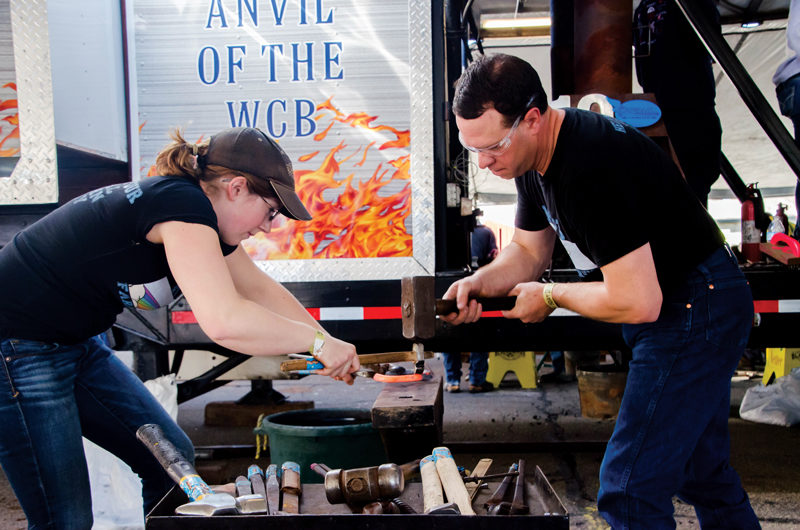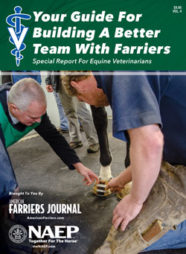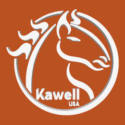Pictured Above: Vern Powell encourages his apprentices to participate in competitions such as the World Championship Blacksmiths (WCB). Powell (right) competes at a WCB event with Heather Beauchemin (left).
Even if you have graduated from shoeing school, this is just a start, in terms of practical knowledge. Learning from someone who has been shoeing horses for many years is invaluable.
Fortunately, there are many opportunities today to further your farrier career and take advantage of learning opportunities.
The Value Of Apprenticeships
Marengo, Ill., farrier Vern Powell enjoys helping young farriers get started by teaching them as apprentices.
“I’ve done this two different ways,” he says. “If they come to me at the beginning having never shod a horse, I have them ride along with me and the other two farriers in my area. They spend time in the forge, much like the English system. They learn to handle the material, make sections and become comfortable with tools in their hands and the forge and comfortable under the horse.”
Powell has them expend the time and energy before going to farrier school.
“They make sure this is what they want to do,” he says. “This also gets them in shape. Most beginning farriers tell me they spend the first several months getting in shape, in shoeing school. It’s hard to learn when your knees are wobbly.”
Learning from a mentor before attending school can help you get in shape, become familiar with the tools and get comfortable under a horse.
A mentorship can give you a leg up on certifications.
Continuing education is invaluable for networking, getting jobs and broadening your knowledge
The second way Powell takes on apprentices is after they have invested 9 months at Kentucky Horseshoeing School.
“They have to stay with me a year,” he says. “After that, I send them to Travis Burns, who is the head farrier at the Virginia-Maryland College of Veterinary Medicine. They’ve had 9 months of school, then a year of practical experience, then they can help Travis and keep learning. When they come back, I try to keep them going and set them up with a practice. I try to model the English system as close as possible, but streamline it and get these young farriers to their journeyman certification in 3 years with a good base of knowledge.”
Powell and his apprentices have been successful using both methods.
“Lexi Klears joined me after she finished shoeing school,” he says. “We prepped her first and she was top of her class as she went through school. Her experience with us gave her an advantage and a solid foundation before going to school.
“We have another associate — Heather Beauchemin — working with us now who came out of school several months ago. The three of us who have full-time practices in the area have shared Heather and Lexi as apprentices.”
Powell prefers to have his apprentices work through certifications and participate in competitions and contests.
“This gives them something to work toward,” he says. “We also work with the vets here and a couple of them come for our study groups. Heather and I are working on a study book portfolio, providing different drills and different approaches for testing, so everyone can learn a little bit different and take advantage of how they learn the best. We use diagrams, pictures, etc., and try to carry these students along after they get out of school.”
Where To Find Mentors
The various farrier organizations are a great place to start if you are looking for a mentor.
“Get in touch with one of the farrier organizations — whether it’s the American Association of Professional Farriers (AAPF), the American Farrier’s Association (AFA) or the Brotherhood of Working Farriers Association (BWFA),” says Chuck Jones, AAPF’s chairman of continuing education. “Ask one of them to hook you up with a farrier and tell them you really want to do this. I guarantee they will give you some contacts.”

Working with a mentor can expose a young farrier to a number of footcare techniques that benefit their career, such as glue-on shoes.
Mike Wharton, a farrier based in York Haven, Pa., and chairman of the AAPF mentoring committee, recently hired a young man and told him, “when he comes back to Florida with me this fall, he will be certified. He was looking forward to that. When you set goals in front of people, it can give them more incentive to try to meet them.”
Importance Of Continuing Education
The aforementioned Travis Burns, who is chairman of the AFA education committee, says continuing education is crucial as things evolve in the industry and new products and techniques become available.
“I think farriers do themselves, the horse owner and the horse a disservice by not keeping up with the latest research, techniques and information, yet it can be difficult for the younger person to keep up or make it to the big conferences and meetings,” he says. “Those are expensive to get to, yet very worthwhile for continuing education and from a networking standpoint. Younger farriers may meet people who can help them get further and who might give them jobs. These types of connections are often made at the big events.”
Each person has different skills and aptitudes and the important thing is to optimize our own talents, says Chuck Jones, a Lexington, Ky., farrier.
“You need to immerse yourself in the industry — with competitions, clinics, conventions, webinars, books, videos, etc. — and continue to do as much as you can to try to better yourself,” he says. “To me, it’s about personal goals. I want to be the best farrier I can be. That doesn’t mean I want to be the best farrier in the world, just the best farrier that I can be.”
The adage that you can’t teach an old dog tricks doesn’t apply here. Wharton, who as been a farrier for 44 years, worked with six different shoers over the past year to learn from, teach or help out.
“This keeps me fresh and it’s also humbling,” he says. “Doing this provides experience you cannot buy. The relationships built are also valuable. If you insist on living inside the box and are unwilling to step out and continue to educate yourself, you’re hurting yourself, your clientele and the horses.”
Apprenticeships Provide A Solid Foundation
Taking part in an apprentice or mentor program opens avenues of learning that a new farrier might not otherwise experience.
Heather Beauchemin firmly believes that her apprenticeship with Marengo, Ill., farrier Vern Powell has built a rock solid foundation for her future in the trade.
“I worked with him for a year and he encouraged continuing education, took me to clinics, certification, etc., and gave me a great start,” she says. “When I was done working for the year I’d signed up for, he hooked me up with other farriers to work with. I strongly feel that the longer you can spend working with others before you go out on your own, the better you’ll be.”
Available Programs
Continuing education has come a long way both in terms of quantity and quality.
“There are incredible opportunities today, compared with when I started shoeing,” Wharton says. “When I started it was hard to learn anything from other farriers; they wanted to keep trade secrets to themselves. When Walt Taylor started the AFA many years ago, and the other organizations came along, this changed. Today, sharing knowledge is wide open. The only limitation for further education — whether practical or books — is yourself.”
There are a number of opportunities to learn more about hoof care — the International Hoof-Care Summit, the AFA Convention, the World Championship Blacksmiths and numerous clinics.
“The farrier industry is unique in that there is a lot of free education,” Burns says. “Most of the supply houses put on a free clinic every year and do a fantastic job, providing a good clinician and usually some food. Larger companies like Delta Mustad, etc., also do a wonderful job of sponsoring and helping with educational clinics. Some are free and some they help sponsor and dramatically reduce the cost for people who come.”
These events can be found on various calendars on the internet — American Farriers Journal, Farrier Product Distribution, AAPF, AFA and several Facebook pages.
“Facebook is another source of information about clinics,” Burns says. “Many connections are made that way, as people in the same areas get together to share rides and share rooms when they get there. Veterinary short courses are another avenue for farriers to learn more about anatomy, physiology, biomechanics, pathophysiology and all those things that a veterinarian benefits from. This could be helpful to the farrier, as well, though it’s often overlooked.”








